<-Previous Species – Next Species->
A recent colonist, the first record in 2019 coming from Harwood Dale, North Yorkshire.
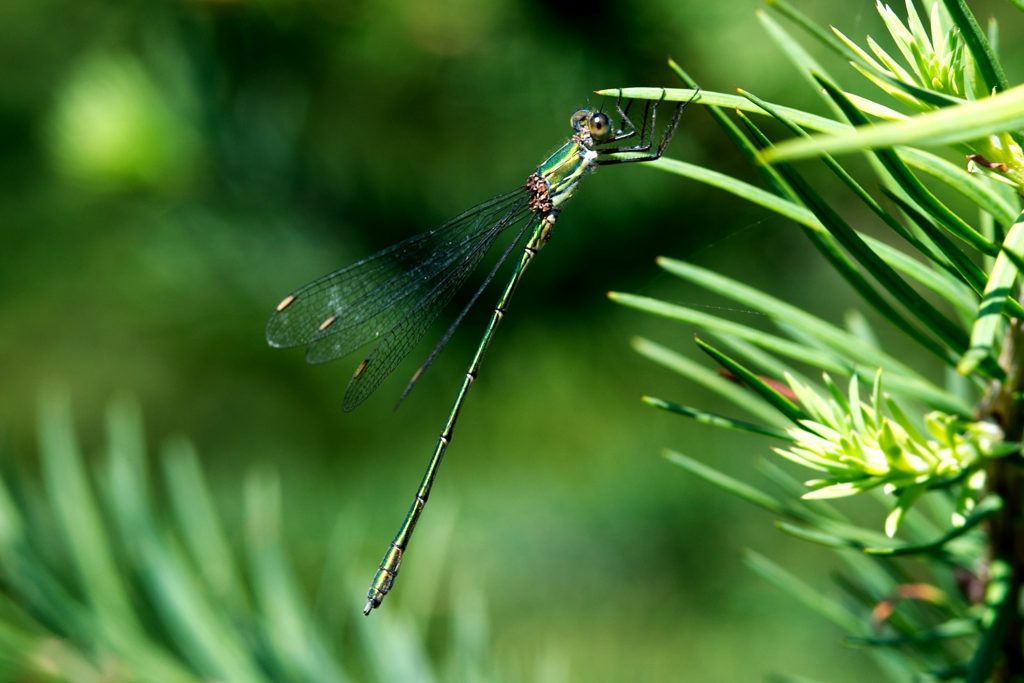 First record for Yorkshire at Harwood Dale, courtesy of Steve Beevers
First record for Yorkshire at Harwood Dale, courtesy of Steve Beevers
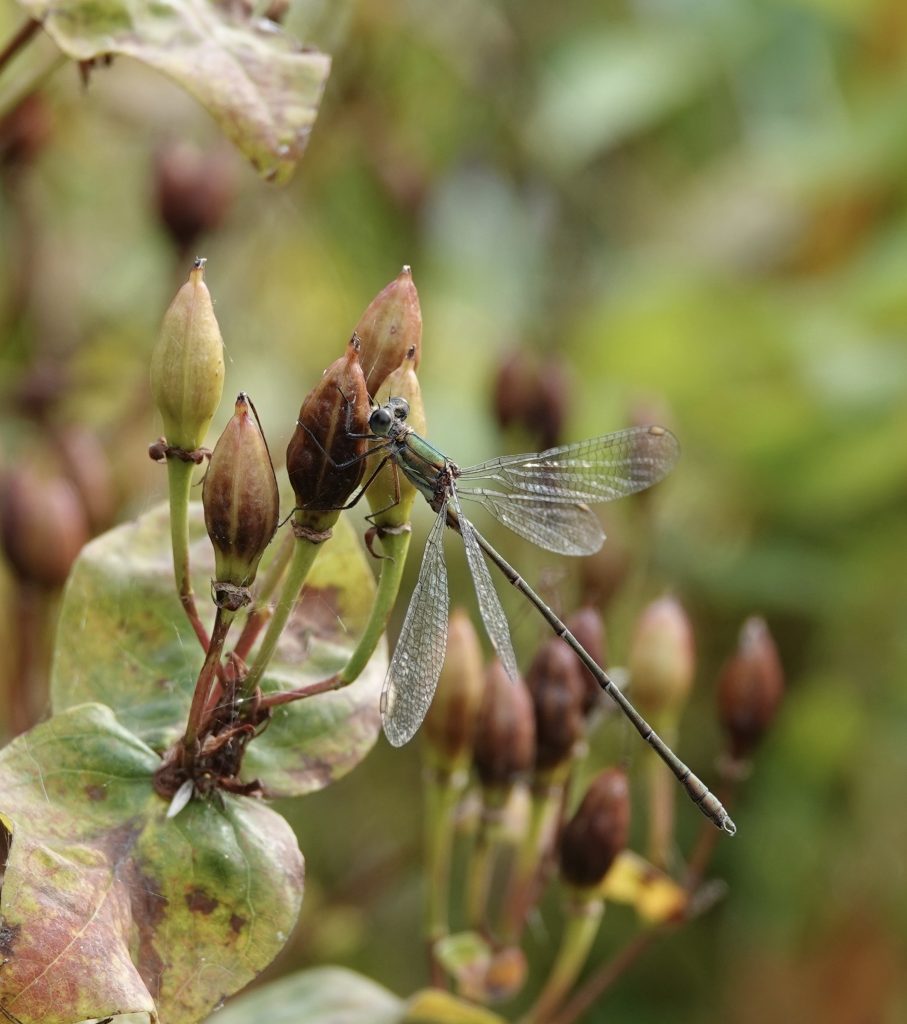 Photo courtesy of Keith Gittens
Photo courtesy of Keith Gittens
www.yorkshiredragonflies.org.uk
<-Previous Species – Next Species->
A recent colonist, the first record in 2019 coming from Harwood Dale, North Yorkshire.
 First record for Yorkshire at Harwood Dale, courtesy of Steve Beevers
First record for Yorkshire at Harwood Dale, courtesy of Steve Beevers
 Photo courtesy of Keith Gittens
Photo courtesy of Keith Gittens
<-Previous Species – Next Species->
29-34mm; Wingspan: 35-40mm; Hindwing 14-21mm
Dark bronze-black metallic with blue segment 8. Blue or green sides to the thorax and antehumeral stripes. Blue eye spots. Pterostigma is distinctive being bi-coloured black and white. Tips of the lower appendages diverge.
Occur in several colour forms dependent on age. Segment 8, though not always blue, is usually clearly different from the other sections. Start as either rufescens with a reddish-pink thorax and blue segment 8 or violacea with a violet thorax and antehumeral stripes, black humeral stripes and blue segment 8. After around eight days they mature and change colour, rufescens become greenish-brown of the form rufescens-obsoleta. The form violacea mature into two separate from. The first is infuscans which is a pale green colour, and retaining the black humeral stripes. The second is an andromorph form which adopts the same colours as a male.
Often found in marginal vegetation in large numbers. Copulation last from between two to six hours, due to this, it is the most frequently observed species seen in the wheel position. Often females selected by the males are still in their immature colour forms. Females oviposit alone onto the tissue of aquatic plants and debris, where they are not usually harassed by the males. Frequently found in dull weather when other species are inactive. Larvae emerge after one to two years.
Wide range including garden ponds, lakes, rivers, canals and ditches. Can also be found in brackish conditions and acidic peaty pools. More tolerant of pollution than other species, only really avoiding fast-flowing water. Readily disperses and is one of the first species to colonise new sites.
Common and widespread throughout the area.
<-Previous Species – Next Species->
<-Previous Species – Next Species->
32mm, Wings 36-42mm
Bright blue body with black markings on upper surface of abdomen, segment 2 has lollipop mark; segment 8 and 9 all blue; broad antehumeral stripes on black thorax; eye spot linked by bar.
3 colour forms:-
1) abdomen with black markings.
2) Green with black markings.
3) Brown with black markings. All have characteristic medial spine under segment 8, presumably puncturing plant material before inserting an egg.
Large ponds and lakes are the main preference for this species. Can also be found along canals and rivers, but will also tolerate brackish conditions. The most abundant Zygoptera found in open areas.
The most dominant species on large lakes and reservoirs, swarming over the waters surface far from the banks in sunny conditions. Readily settles on emergent vegetation and is aggressive towards others, even driving away larger species. Copulation lasts for around 20 minutes, frequently away from water. Oviposits into submerged and emergent vegetation, usually in tandem. If the female submerges the male will uncouple, guarding the area waiting for her to re-emerge. Females can submerge for up to an hour. Larvae live amongst submerged vegetation emerging after 1-3 years. They mature in surrounding areas over a period of around 12 days.
Occurs on a wide range of varying water-bodies. Can be more conspicuous than the similar Azure Damselfly. Blue damselflies ranging far over open water are usually this species. Generally the most abundant blue damselfly at sites, where the Azure can be absent.
<-Previous Species – Next Species->
63mm, Wings 87mm
Thorax brown with broad thoracic stripes, with short indistinct antehumeral stripes; abdomen brown, yellow triangle mark on segment 2, separate pairs of blue spots along rest of abdomen; legs brown; eyes bluish; wings have brown costa.
Thorax antehumeral stripes very restricted, often missing; abdomen brown with small yellow-brown spots; long anal appendages. Brown costa, leading edge to the wing.
Still or slow-flowing waters including ponds, lakes, sand and gravel pits, reservoirs, slow-flowing rivers, canals and ditches. Will tolerate brackish conditions, though avoids acidic water.
None territorial and often present in high densities with little sign of aggression. Frequently hovers, searching for females in marginal vegetation. Both sexes can be found well away from water in sheltered locations, such as woodland rides and hedgerows. Regularly found perched in the open. Copulation is lengthy and once complete, the female will oviposit alone. Oviposition usually occurs into emergent plants above the water, though occasionally in bare mud. Emergence usually occurs the following year, often during the night. Despite being abundant late in the season, few exuviae have been found. Those that have been recovered are usually found low down in thick vegetation. Due to the lack of breeding data, it would suggest that the majority of adults observed are migratory individuals.
<-Previous Species – Next Species->
73mm, Wings 102mm.
Thorax brown; abdomen brown with bright blue spots at sides; wings characteristically honey brown colour; legs pale brown.
As males except blue spots on abdomen replaced with yellow markings.
Lakes, ponds, gravel pits, canals, ditches and slow-flowing rivers. Will tolerate moderate levels of pollution.
Males are territorial, even defending territories away from water. They are often observed hawking along woodland rides and hedgerows. This is a difficult species to approach when settled, the first sign of their presence is usually the rustling of wings, as the fly up from roosting places in tall grasses. Copulation is lengthy, the female then ovipositing into emergent floating vegetation, or decaying floating logs, where several females may oviposit together. Larvae emerge two to four years later at night, with the maiden flight taking place before dawn.
<-Previous Species – Next Species->
78mm Wings, 106mm.
Thorax bright green; abdomen blue with black central line; legs black; eyes green; wings clear with yellow costa.
Generally greenish with thicker black central abdominal line.
Ponds, lakes, gravel pits, dykes, canals and slow-flowing rivers with rich marginal vegetation, also tolerant of brackish conditions. Seldom found far away from water.
Males are territorial, rarely more than one male is present at small locations. Constantly patrols its territory, which it defends vigorously. Will take prey as large as Four-spotted Chaser Libellula quadrimaculata. Copulation takes place away from water and lasts around ten minutes. The female then oviposits alone into submerged vegetation. Larvae emerge after two years on to tall emergent vegetation. Emergence is usually synchronous at site level.
<-Previous Species – Next Species->
50mm, Wings 78mm
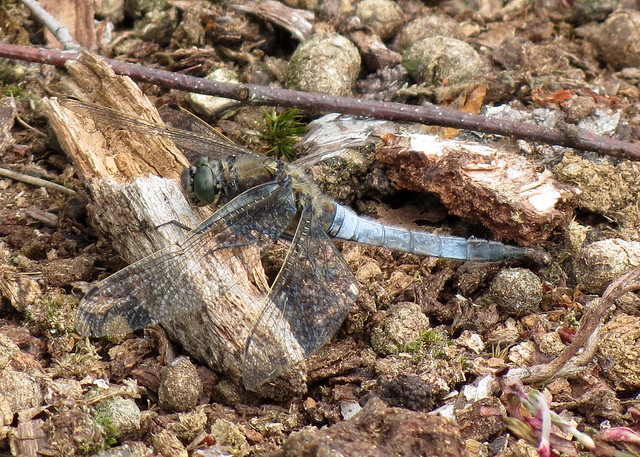
Thorax black, no antehumeral stripes; Abdomen top is blue with yellow spots towards sides, black tip; legs black.
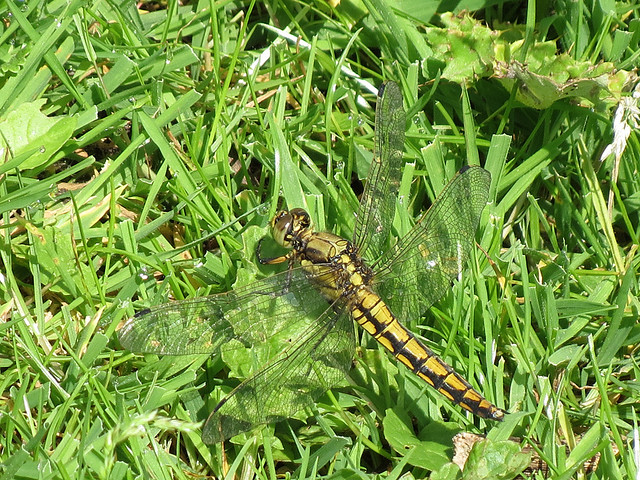
All yellow with 2 black bands on upper surface abdomen.
Prefers lakes, ponds, gravel workings, slow rivers or marshes, with exposed mud, stones or bare patches where the male can perch.
Highly territorial, males perch on bare areas of ground, typically on slightly raised areas such as stones, logs or bare soil, on the lookout for females and rival males. When patrolling over water they fly low, skimming over the surface. Copulation can take place in flight, where it will only last for a few seconds, though sometimes this can take place in vegetation where it may last up to 15 minutes. Oviposition occurs by dipping the abdomen into water, with the male often remaining nearby. Larvae live amongst the bottom silts, emerging after two to three years. Emergence usually takes place on vegetation, often several metres away from water.
<-Previous Species – Next Species->
37mm, Wings 57mm.
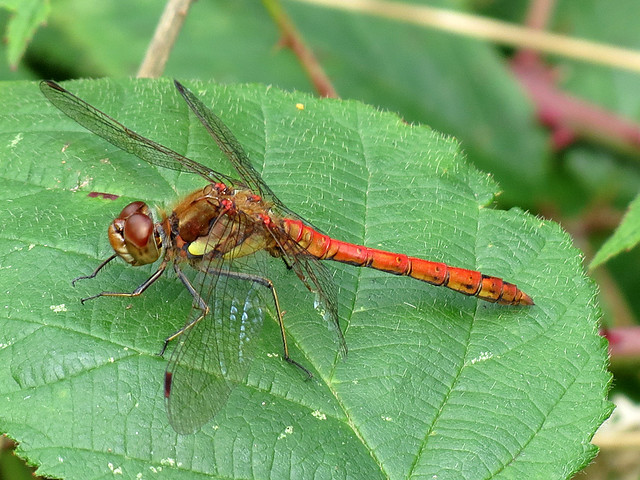
Thorax brown with yellow patches on sides; abdomen orange/red with black central line last 2 segments ; legs black/yellow; eyes brownish; black line on top of the frons only.
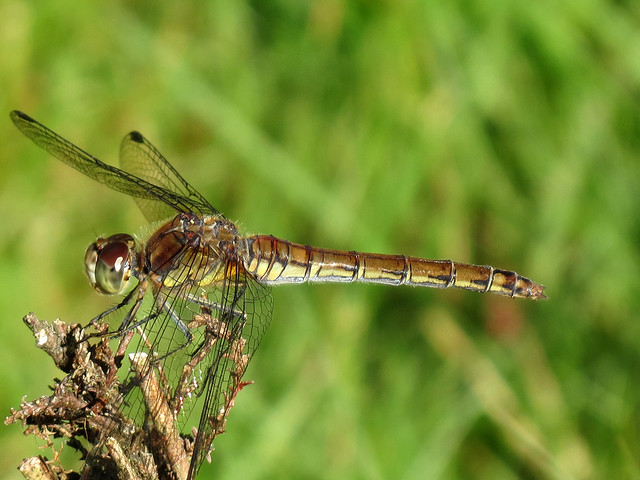
Thorax pale brown with yellow side panels; abdomen yellow with black central line segments 9-10 and along sides. Old females tend to take on male colours.
Preferences are quite catholic, including ponds, lakes, canals, ditches and slow-flowing rivers. It is tolerant of brackish conditions and peaty bog pools. Can be found away from breeding sites feeding in sheltered locations, like woodland rides and hedgerows.
Males are territorial, spending a lot of time perched, only making short flights when disturbed or chasing off intruders. Basks on the ground, especially late in the season when temperatures are lower. Frequently found away from water in sheltered areas, especially females wanting to avoid attention from males. Copulation takes place at rest, lasting around 10-15 minutes. Oviposition regularly takes place in tandem, where the eggs are flicked into the water by dipping the abdomen onto the surface. Females will also oviposit alone. Larvae emerge after one year, this taking place during the morning, onto bare bank sides or emergent vegetation.
<-Previous Species – Next Species->
40mm, Wings 63mm
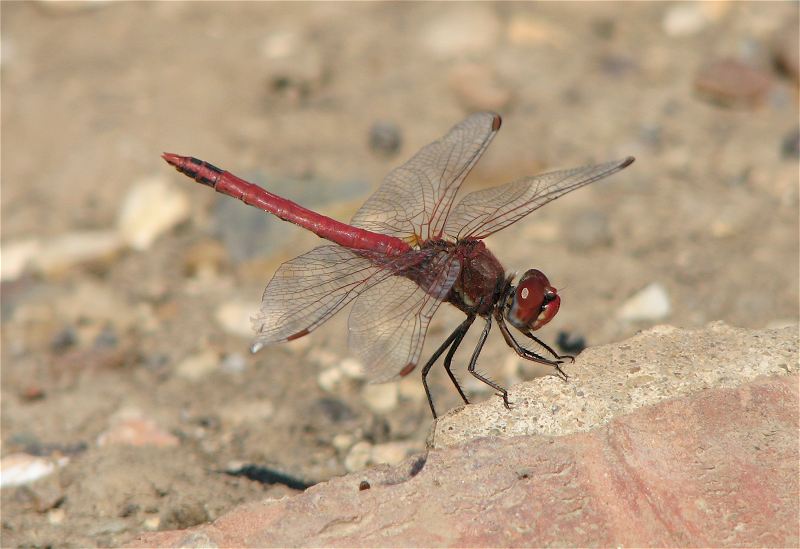
Brick red colour with central black line on segments 8 and 9; basal veins of wings near leading edges are red with a yellow patch at the base of the hind wing; underside of eyes are blue.
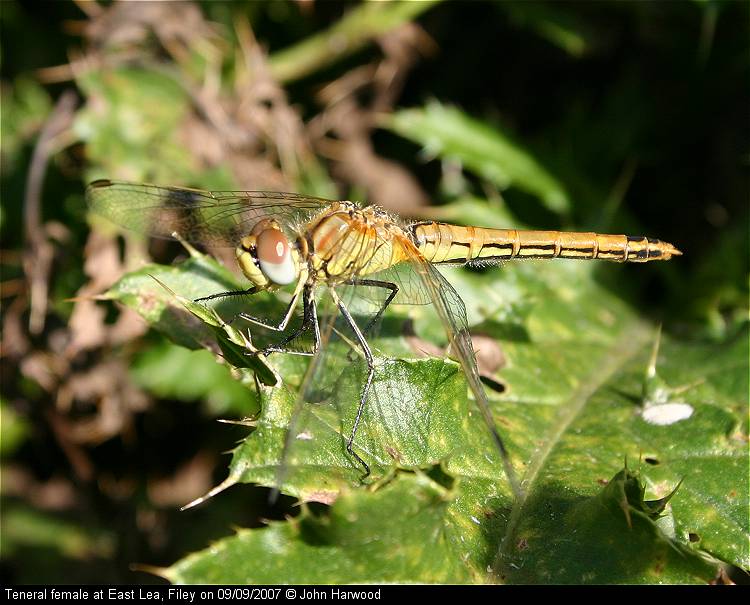
Body yellow with central black line on segments 8 and 9; yellow patch at base of hind wings and veins at front edge of wings also yellow; underside of eyes blue.
Vagrant from Europe, although it has colonized some areas of Great Britain. In the East Riding the best site is the scrape in Clubley’s field at Spurn Point. Shallow ponds, pools and ditches.
Males are territorial, perching on the ground or adjacent vegetation, only flying off to intercept intruders. Frequently hovers over open water. The pair usually oviposit in tandem in areas of shallow water. The warmer water in shallow conditions helps the larvae develop quickly, sometimes resulting in a second generation emerging in the same year. They are strongly migratory, with strong influxes in some years, then none in others. These irregular influxes make it difficult to assess if this species is breeding on a regular basis.
<-Previous Species – Next Species->
34mm, Wings 55mm.
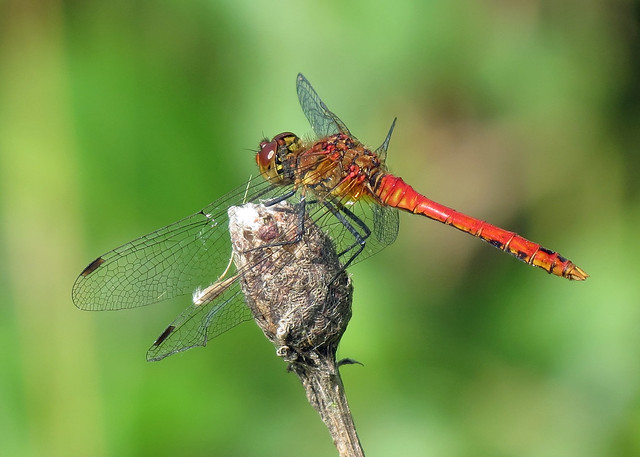
Thorax brown with 2 thin black lines on sides; abdomen narrow waist, rich red colour; face red; legs all black; line over frons spreads down the sides.
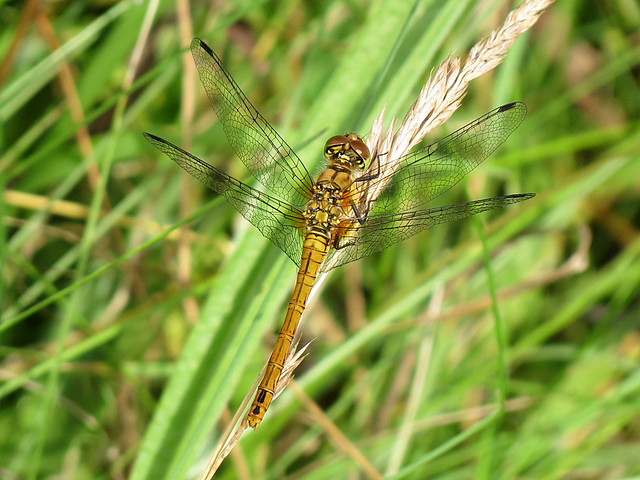
Yellowish throughout with black markings on sides of thorax and abdomen; legs all black.
Marshes, ponds, lakes, canals and ditches, with plenty of tall emergent vegetation. Will tolerate brackish conditions, using woodland near to water bodies for shelter.
Males are less aggressively territorial than Common Darter Sympetrum striolatum. They have a ‘skippy’ flight, being less direct than the latter species. Copulation lasts only a few minutes whilst perched on vegetation or the ground. The female will then oviposit either alone, or in tandem, amongst shaded vegetation. Larvae live among submerged plants and emerge after one year.